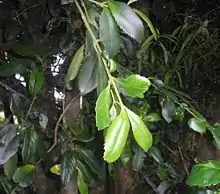Laurelia sempervirens
Laurelia sempervirens, commonly called Peruvian nutmeg,[2] from mapuche: tihue, trihue, also called Chilean laurel[3] or Chilean sassafras. It is a species of Evergreen tree in the family Atherospermataceae, formerly Monimiaceae, in the southern hemisphere genus of plant Laurelia, not closely related to Lauraceae despite the similarity. It is endemic to Chile. It occurs 34–41° South Latitude. They require a warm subtropical to tropical climate that is cool but also frost-free or with only very slight winter frosts not below -4 °C, and with high summer heat, rainfall, and humidity. This is, the laurel forest habitat. The Tihue grows best on well-drained, slightly acidic soils rich in organic matter.
| Laurelia sempervirens | |
|---|---|
 | |
| Scientific classification | |
| Kingdom: | Plantae |
| Clade: | Tracheophytes |
| Clade: | Angiosperms |
| Clade: | Magnoliids |
| Order: | Laurales |
| Family: | Atherospermataceae |
| Genus: | Laurelia |
| Species: | L. sempervirens |
| Binomial name | |
| Laurelia sempervirens | |
| Synonyms[1] | |
| |
The tree is known as triwe in Huilliche and laurel in Spanish.[4] It is the ritual tree of the Huilliche people of Futahuillimapu.[4]
Description
The tihue is a large ( up 30 m. tall to 2 m. diameter) evergreen, Laurel forest tree with smooth, pale yellow bark. The bark cracks when ageing, coming off in roughly circular plates. The wood and the leaves are strongly aromatic. The bright green leaves of the Chilean laurel are arranged in opposite pairs, and are oblong in shape, narrowed at the base. The leaves are leathery, shiny, and around 5 to 10 centimetres long and 2.5 to 5 centimetres wide. The serrated edges of the leaves help to distinguish this tree from the closely related Laureliopsis philippiana, which has more deeply toothed leaf margins. The tihue bears bundles of small yellow unisexual flowers, both male and female on every tree (monoecious).[5] The fruit is a greenish achene with seeds bearing feathery anemophilous filaments. The seed is dispersed by the wind (anemochory).
Cultivation and uses
Its wood is pale-yellowish, with growth rings little notorious and homogeneous and fine texture. It is threatened by habitat loss. It has been introduced into Spain[6] and into Cornwall[7] and planted in Sussex[8] in the UK. The leaves of Laurelia sempervirens were used by Mapuche Amerindians for treating headache and as diuretic. [4]
References
- "The Plant List".
- "Laurelia sempervirens". Germplasm Resources Information Network (GRIN). Agricultural Research Service (ARS), United States Department of Agriculture (USDA). Retrieved 14 January 2018.
- Mabberley, D.J. (1997). The plant book: A portable dictionary of the vascular plants. Cambridge: Cambridge University Press.
- Rumian Cisterna, Salvador (2020-09-17). Gallito Catrilef: Colonialismo y defensa de la tierra en San Juan de la Costa a mediados del siglo XX (M.Sc. thesis) (in Spanish). University of Los Lagos.
- Martínez-Laborde, Juan B. (1983). Revision de las Monimiaceae Austroamericanas. Parodiana 2(1): 1–24.
- "Chilean plants cultivated in Spain" (PDF). José Manuel Sánchez de Lorenzo-Cáceres. Archived from the original (PDF) on 2009-03-20. Retrieved 2009-06-27.
- Trebah plant and tree inventory 2007, ISBN 0-9521952-1-6: The Trebah specimens of L. sempervirens are catalogued as TB141 and TB198. The latter had a girth of 1.63 metres and a height of 19.05 metres in 2007. There is also a mature specimen at Enys garden, labelled as a "Peruvian laurel". There are probably several other mature specimens in gardens in Cornwall.
- "Half-hardy trees in Britain and Ireland - part two". Royal Horticultural Society. Archived from the original on March 11, 2013. Retrieved 2009-06-27.
- González, M. 1998. Laurelia sempervirens. 2006 IUCN Red List of Threatened Species. Downloaded on 22 August 2007.
- Laurelia sempervirens in Encyclopedia of Chilean Flora
- Images of Laurelia sempervirens from 'Chilebosque Web site
- Plants for a future database: Laurelia sempervirens. - British commentary on this tree.

